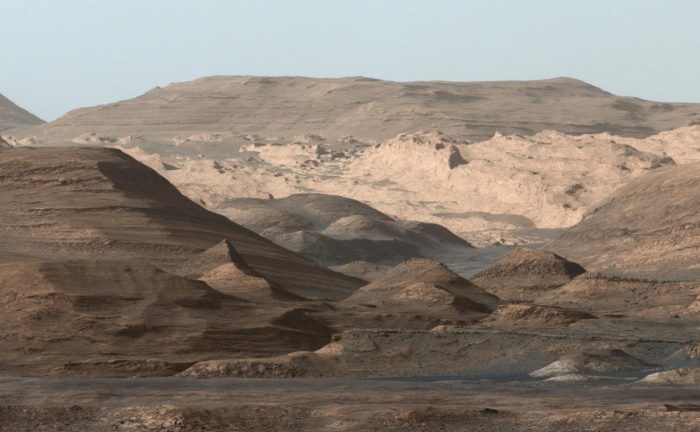NASA’s Curiosity Rover Just Licked A Mountain

Since it first landed on the surface of Mars on August 6th, 2012, the science team behind the Curiosity rover has conducted some crucial experiments. In the course of collecting rock samples, testing the air, and searching for organic molecules, the rover has revealed some very impressive things about Mars’ past.
After months of exploring the slopes around Mount Sharp, which sits in the ancient lake basin known as the Gale Crater, the rover team has been drilling into the formation see what’s hidden beneath. And with drill samples now obtained from Mount Sharp’s lower levels, the Curiosity team hopes to learn a great deal more about the planet’s ancient history.
For years, scientists have understood that Mount Sharp is essentially a giant mound of sedimentary deposits that were deposited by water billions of years ago. These sediment layers are believed to have been laid down over the course of 2 billion years, and most likely came into contact with the water that filled the crater 3.3. to 3.8 billion years ago.
As Ashwin Vasavada, the Deputy Project Scientist of the Curiosity mission at JPL, explained to Universe Today via email:
“Aeolis Mons, known informally as Mount Sharp, is the central mountain within Gale crater where Curiosity landed. It was chosen as Curiosity’s landing site because the mountain and the nearby plains have evidence for ancient liquid water in the form of channels and debris fans, as well as minerals that form when liquid water interacts with rock. Furthermore, the layers within lower Mount Sharp change in mineralogy in a way that indicates that they may record the drying out of Mars: lower and older layers indicate more water, while higher and younger layers indicate less.“
The drilling began late on Wednesday, Sept. 24th, when Curiosity’s hammering drill bore about 6.7 cm (2.6 inches) into Mount Sharp and collected a powdered-rock sample. Data and images of the drill sample were then received on the following morning (Thursday, Sept. 25th) at NASA’s Jet Propulsion Laboratory in Pasadena, California.
With drill samples now obtained from the lower level of Mount Sharp, Curiosity will soon deposit them into a scoop in the rover’s arm. While there, the rock powder will be examined to see if it is safe and of proper quality to be analyzed by Curiosity’s internal laboratory instruments, which will determine its chemical and mineralogical properties.
And once that analysis is complete, the Curiosity team hopes to make some more major discoveries of the region, the ultimate purpose of which is to determine if life could have existed in the Gale Crater during its warmer, wetter past. As Vasavada explained:
“Now that water-rich ancient environments have been discovered and studied on the plains and in the lowest layers of Mount Sharp, the team in drilling additional samples from progressively higher and younger layers to see how the ancient environment changed over time.
“The team also is searching for additional evidence of organic molecules that would help them understand whether the raw ingredients of life were present and how they degrade over time. The degradation is important to understand for the M2020 Mars rover mission that will search for signatures of ancient microbial life.”
Since September 11th, 2014, Curiosity has been exploring the slopes of Mount Sharp. As of Sept. 19th, 2016, the rover arrived at a area called “Pahrump Hills,” a basalt rock outcropping located in the lower region of Mount Sharp (known as the Murray Formation).
On Sept. 22nd, the rover completed mini-drill test to make sure the rock was suitable for drilling. This took place in an area known as “Confidence Hills”, which proved to be soft enough to obtain rock samples. This was the second mini-drill test since last month, the previous one having found that the rock was not stable enough for drilling.
Looking forward, the team plans to drill regularly as the rover climbs higher and higher along Mount Sharp, in the process accessing progressively younger layers of rock. In so doing, they will be able to create a comprehensive picture of how Mars evolved over time to become the dry and cold landscape it is today.
The team will also continue to use the rovers instruments to monitor the modern environment, including the weather and composition of the atmosphere to get a better picture of the planet’s meteorology today. Needless to say, this is not the last “taste” Curiosity will get of good ol’ Aeolis Mons!
Be sure to check this video too – “A Taste of Mount Sharp” – courtesy of NASA JPL:
Further Reading: NASA
The post NASA’s Curiosity Rover Just Licked A Mountain appeared first on Universe Today.
